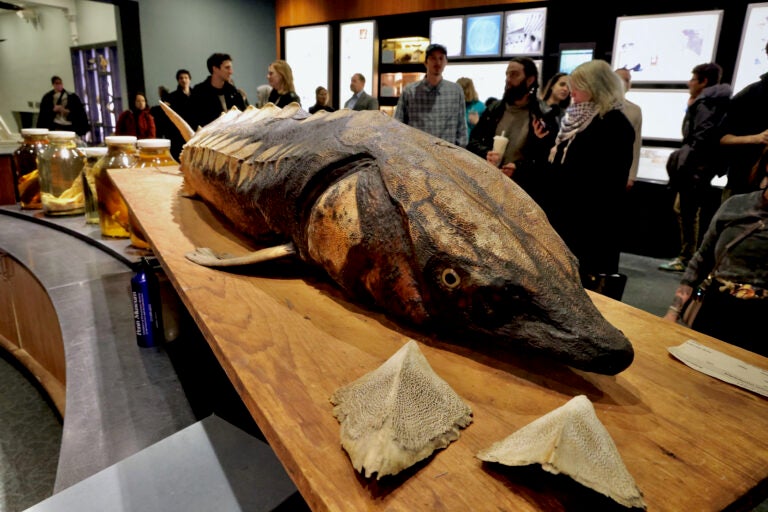EPA announces commitment to protect fish in the Delaware River
The announcement comes after environmentalists took legal action to speed up the process.
Listen 1:14
An Atlantic sturgeon preserved more than 100 years ago with straw and creosote is part of the collection of the Academy of Natural Sciences of Drexel University. (Emma Lee/WHYY)
This story is part of the WHYY News Climate Desk, bringing you news and solutions for our changing region.
From the Poconos to the Jersey Shore to the mouth of the Delaware Bay, what do you want to know about climate change? What would you like us to cover? Get in touch.
The U.S. Environmental Protection Agency announced Tuesday that it plans to finalize new water quality standards that aim to protect fish in a portion of the Delaware River.
The announcement comes more than a year after the protections were first proposed, and after environmentalists took legal action to speed up the process.
Some fish traveling the river between Philadelphia, South Jersey and Wilmington struggle to survive and thrive due to low dissolved oxygen levels caused by ammonia discharges from wastewater facilities.
This urban stretch of the Delaware River is the only section of the region’s waterways that isn’t fully protective of aquatic life, according to the EPA, and oxygen level criteria doesn’t meet Clean Water Act standards.
Environmental groups and scientists have called for improved fish protections in the Delaware River for more than a decade, voicing concerns about the federally endangered Atlantic sturgeon. These monumental fish that predate the dinosaurs once thrived in the Philadelphia region, but are now threatened by habitat loss, dams, vessel strikes and poor water quality.
EPA Administrator Lee Zeldin on Tuesday said the new standards, which have not been updated in 50 years, align with his “Powering the Great American Comeback Initiative,” which aims to improve water quality.
Once finalized, the new standards will determine the levels of oxygen fish need in order to flourish along 38 miles of the Delaware River, and update protections for fish of all life stages, including fertilized eggs and larval stages.
“When finalized, this action will protect two species of endangered sturgeon and prove to be a boon for commercial and local fishing by also protecting American shad, striped bass and yellow perch,” Zeldin said in a statement.
In order to meet the oxygen levels outlined in the new standards, wastewater facilities would be forced to treat ammonia before discharging into the estuary.
The EPA’s announcement comes as welcome news to the Delaware Riverkeeper Network. The environmental group and scientists have for years urged the Delaware River Basin Commission, which oversees the region’s water quality, to increase its 1967 criteria for dissolved oxygen levels.
In 2022, the riverkeepers petitioned the federal government to step in and take action, which resulted in the EPA’s 2023 proposed standards. However, when the agency did not meet a deadline to finalize those standards, the riverkeepers filed suit in the U.S. District Court for the Eastern District of Pennsylvania.
On Tuesday, the EPA notified the court of its intent to finalize the proposed water quality standards. The Delaware Riverkeeper Network’s Maya van Rossum said the move indicates the EPA is committed to issuing regulations that are “protective of the Delaware River and its aquatic life,” and that “protect sturgeon from extinction.”
Some water providers aren’t as thrilled with the announcement. In a statement on Wednesday, the Philadelphia Water Department said though it agrees water quality standards must be updated, the EPA’s proposal is “overly stringent, not developed with sound science, and could significantly increase PWD customer bills.”
The department said it hopes to work with the EPA on a rule that would improve water quality while also ensuring affordable water rates for customers.
The Riverkeeper Network’s van Rossum argues the new rules will “level the playing field” between the water department and other municipalities already using ammonia treatment technologies.
“It is totally unfair that the Philadelphia Water Department has been allowed to get away with not putting in place those standard treatment technologies that everybody else is putting in place,” she said.
In 2017, the water department proposed building a facility to reduce ammonia discharges from its Southwest Water Pollution Control Plant, and secured a state loan for the $74 million project. However, upon further evaluation, the department is reconsidering whether the project has long-term viability and is assessing other cost-effective options.
Van Rossum said improving oxygen levels will not only benefit a whole range of aquatic life but also boost fishing and recreation along the Delaware River.
“[Improved water quality is] important for people who enjoy fishing recreationally, and that’s also important for those who fish economically,” she said. “And it means that we are better protecting the quality of the water that we all depend upon, whether we’re drinking that Delaware River water or trying to enjoy it for swimming, boating, fishing.”
WHYY is your source for fact-based, in-depth journalism and information. As a nonprofit organization, we rely on financial support from readers like you. Please give today.







